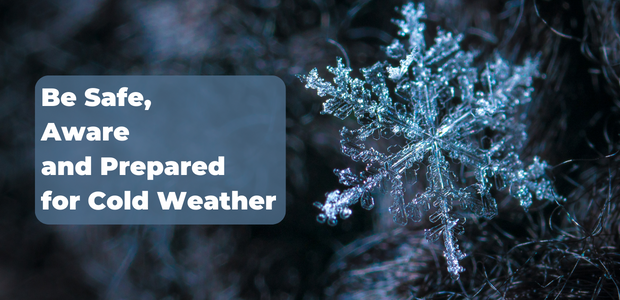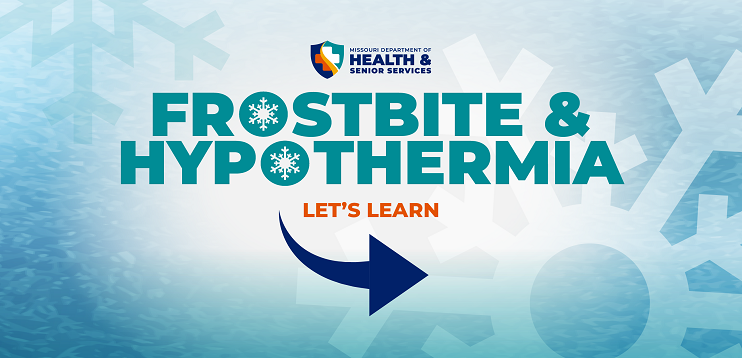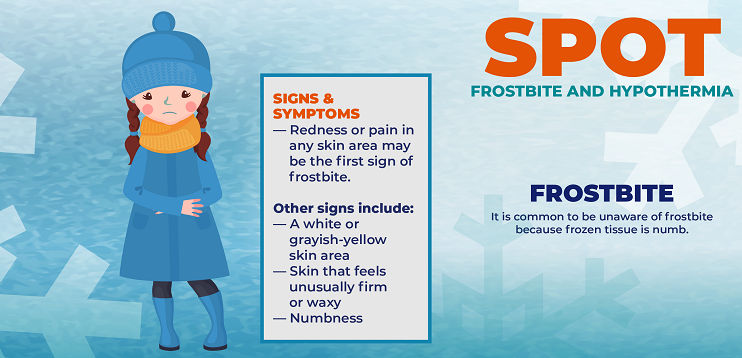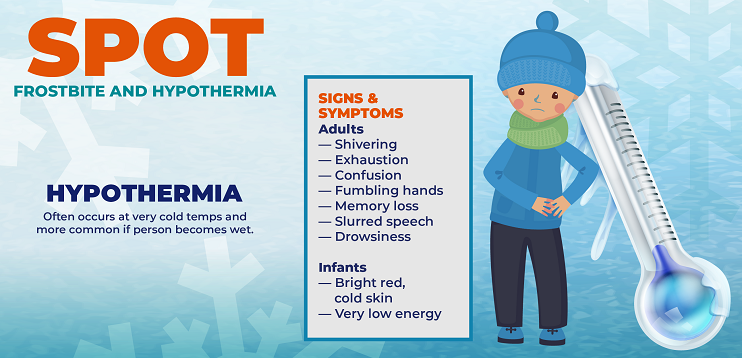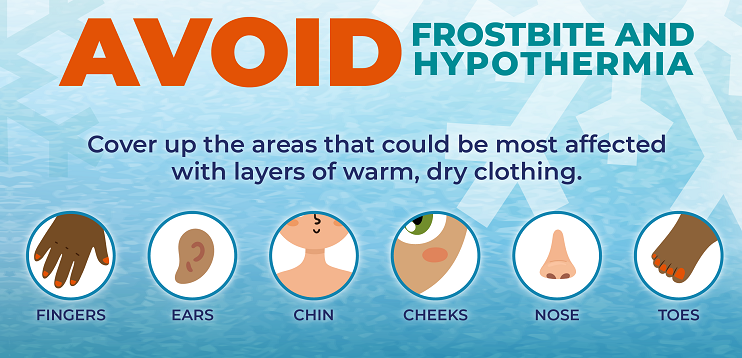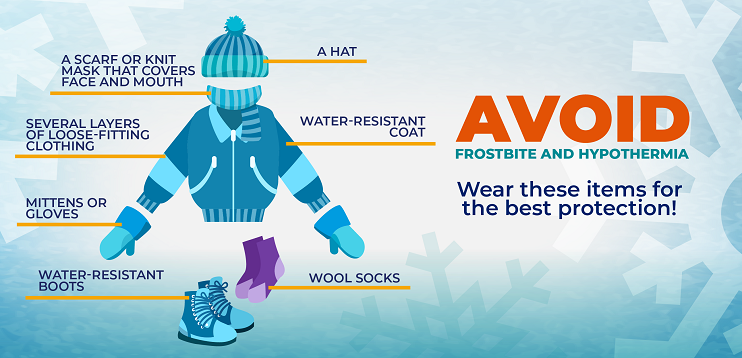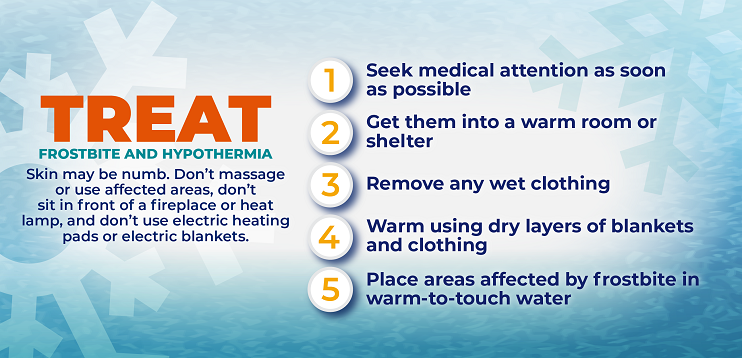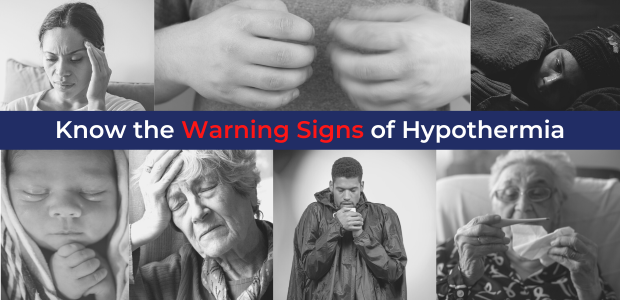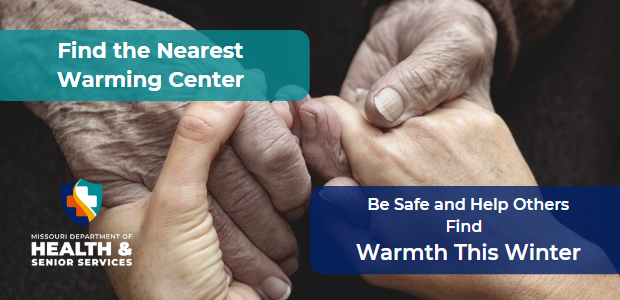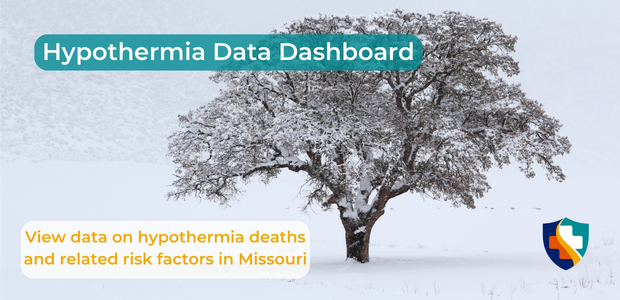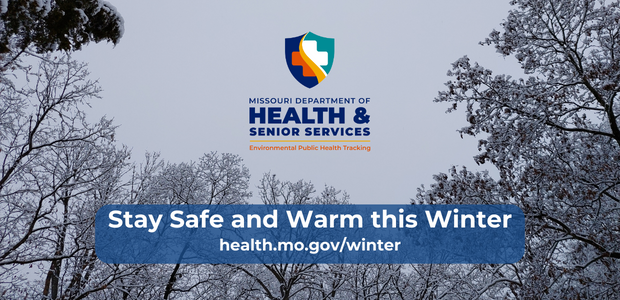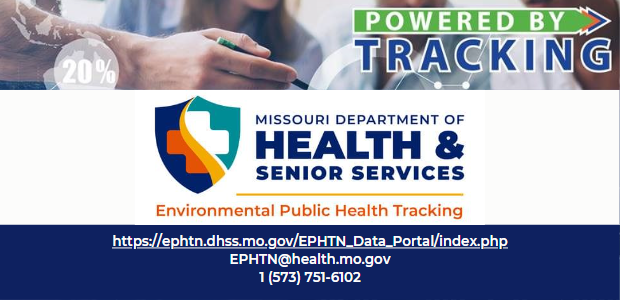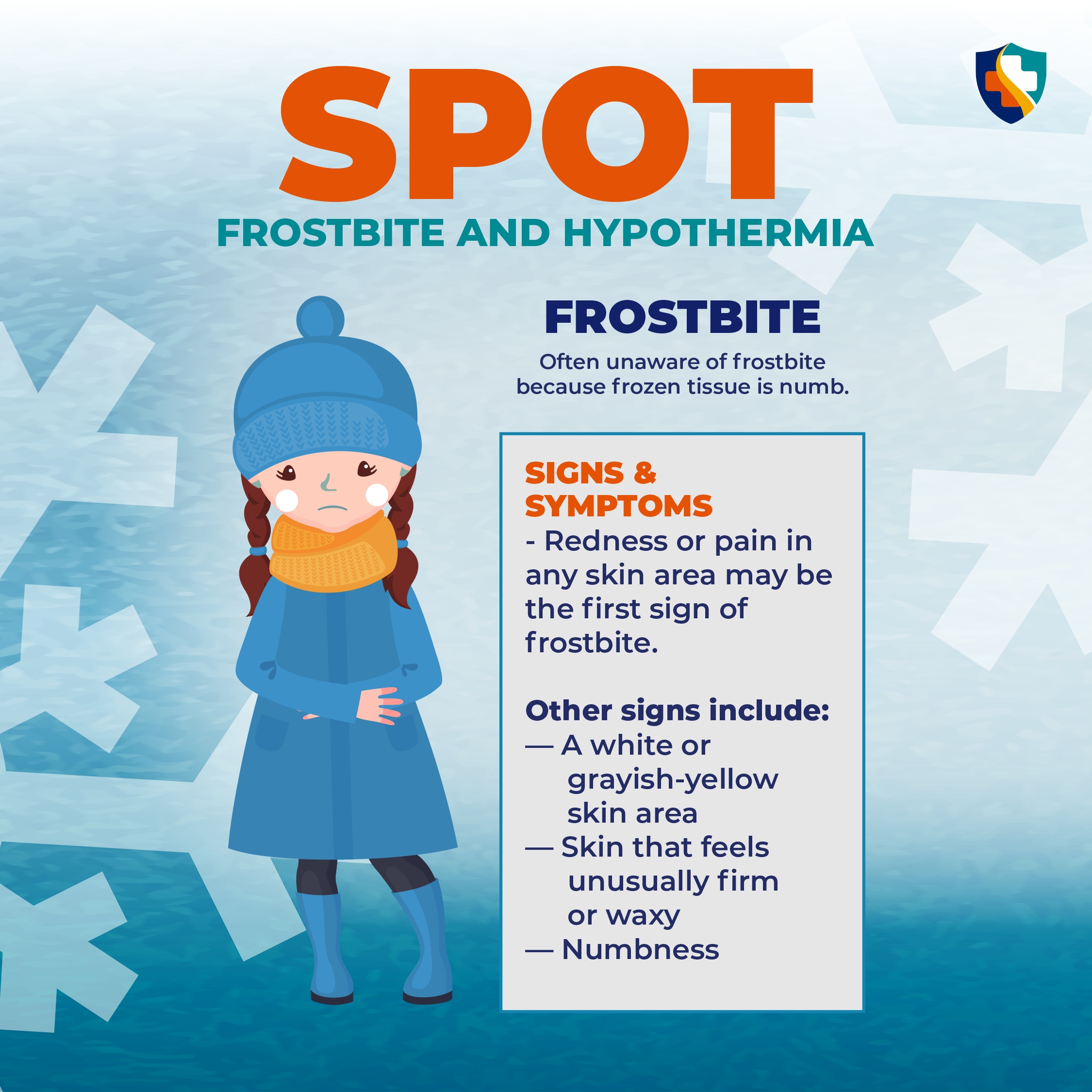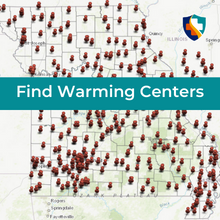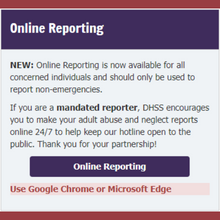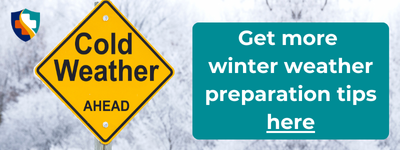Hypothermia

Hypothermia (hi-poe-THUR-me-uh) is defined as a drop in body temperature to less than 95 degrees Fahrenheit (°F) or 35 degrees Celsius (°C) as result of exposure to cold weather or a natural environment. Hypothermia occurs when the body loses heat faster than it’s produced. Hypothermia is dangerous and can quickly become life threatening. Don’t wait - call 911 first if you or someone else is showing signs of hypothermia!
Body temperature can drop when a person spends a long period of time exposed to cold temperatures. Loss of body heat can also occur when a person becomes wet with water or sweat, even in milder temperatures. It is important to note this condition can happen indoors as well as outdoors, especially when someone isn’t properly clothed or lives in a poorly heated home. Factors that contribute to hypothermia include:
- substance influence or abuse (alcohol and drugs),
- underlying medical condition (such as heart disease, diabetes, dementia or other mental health condition; sometimes the medications used to treat them),
- accidental falls, immersion in water, and motor vehicle accidents,
- outdoor work or hobbies,
- lack of resources (food, clothing and shelter), and
- age (infants and young children, and older adults are especially vulnerable).
AVOID. SPOT. TREAT. Frostbite and Hypothermia
Hypothermia can happen to anyone; however, some people are at greater risk and may need assistance to stay safe in cold weather.
Download cold weather graphics for social media.
Be Safe, Aware and Prepared for Cold Weather
Find a Warming Center
Locate nearest warming centers in Missouri for a place to warm up. For overnight shelter from cold, call United Way 2-1-1 or contact local emergency management.
Protect Adults in Need
Report older adults and adults with disabilities in need of assistance due to cold temperatures.
You can make a report 24/7 online or call the state's toll-free number 1-800-392-0210. Operators are available 7:00 a.m. to 8:00 p.m. seven days a week.
View Hypothermia Data
View data and information on hypothermia deaths and associated risk factors in Missouri, vulnerable populations, and resources to stay safe in cold weather.
Are you or someone you know in need of help with home utility costs? Visit the Department of Social Services’ Low Income Home Energy Assistance Program to learn more.
Warning Signs of Hypothermia
Warning signs of hypothermia may include:
- Uncontrollable shivering. In severe cases of hypothermia, shivering stops
- Numbness
- Glassy stare
- Apathy
- Weakness
- Impaired judgment
- Drowsiness
- Slow or slurred speech
- Exhaustion
- Loss of consciousness
- Bright red skin and very low energy level in infants
What to Do Until Help Arrives
After calling 911 for immediate medical assistance,
- Gently move the victim to a warm place
- Monitor the victim’s blood pressure and breathing
- If needed, give rescue breathing and CPR
- Remove wet clothing
- Dry off the victim
- Take the victim’s temperature
- Warm the body core first, NOT the extremities. Warming the extremities first can cause shock. It can also drive cold blood toward the heart and lead to heart failure
- DO NOT warm the victim too fast. Rapid warming may cause heart arrhythmias
How to Prevent Hypothermia
- Be aware of the warning signs of cold-related illness, such as uncontrollable shivering, sleepiness, confusion, changes in skin color, slurred speech and loss of consciousness.
- Stay indoors and in a warm area. If heat is not available, consider a visit to a shopping mall, public library, movie theater, church, community building or shelter.
- Increase your fluid intake – regardless of your activity level. Don’t wait until you feel thirsty to drink fluids. Ensure infants and children drink adequate amounts of liquids.
- Avoid drinks containing caffeine and alcohol because they affect how your body reacts to the cold. Warm fluids such as broth or juice are good, as well as sports drinks.
- Wear something on your head. Fifty percent of all body heat is lost through the head so wearing a hat will keep your whole body warmer.
- Protect the ears and face. Wear a scarf to protect your lungs from cold air – it will also protect your ears and face.
- Wear waterproof boots.
- Several layers of clothing is better than a single heavy layer. The space between the layers works as insulation to help keep you warmer.
- Check with your doctor or pharmacist if you are taking prescription drugs. Some drugs can affect the way your body reacts to the cold.
- Minimize sitting or squatting in the cold for prolonged periods of time. These activities can hinder circulation.
- While outdoors, take frequent breaks in a warm place.
- If you have to be outdoors, schedule outdoor activities during the warmest part of the day, usually 10 a.m. to 3 p.m.
- Adjust to outdoor activity. Stretch and do a few exercises before going outside to work to avoid muscle strain. Extreme cold puts extra strain on the heart – no matter what your age or physical condition.
- Use the buddy system. Monitor the condition of your co-workers and have someone do the same for you. The buddy system can be used to inspect for signs of frostbite. Just before freezing, the skin, especially on the face, becomes bright red. Then small patches of white appear, as freezing actually occurs.
- Prevent chapped skin by frequent application of protective lotions.
- Carry extra clothes with you such as socks, gloves, hats and jacket so you can change them if you get wet.
Frostbite
Frostbite is the actual freezing of the tissue or a body part. It often affects the ears, nose, fingers and toes. Warning signs of frostbite include:
- Pale or waxy white or grey skin
- Numbness
- Tingling or stinging sensation in the affected body part
- Aching in the affected body part
- Reduced blood flow
If frostbite is detected, seek medical care. If there is frostbite but no sign of hypothermia and immediate medical care is not available, do the following:
- Move to a warm dry area
- Remove wet or tight fitting clothes
- Avoid walking on frostbitten toes or feet
- Gently place affected area in warm water – DO NOT use water any hotter than 105°F
- DO NOT use a heating pad, heat lamp or stove, fireplace or radiator for warming
- DO NOT rub affected area, this can cause more damage
- After warming, the injured area should be wrapped in sterile gauze, keeping the affected fingers and toes separated
- If normal sensations haven’t returned in 30 minutes, seek medical attention
How to Prevent Frostbite
- Be aware of the warning signs of cold-related illness, such as uncontrollable shivering, sleepiness, confusion, changes in skin color, slurred speech and loss of consciousness.
- Stay indoors and in a warm area. If heat is not available, consider a visit to a shopping mall, public library, movie theatre, church, community building or shelter.
- Increase your fluid intake – regardless of your activity level. Don’t wait until you feel thirsty to drink fluids. Ensure infants and children drink adequate amounts of liquids.
- Avoid drinks containing caffeine and alcohol because they affect how your body reacts to the cold. Warm fluids such as broth or juice are good, as well as sports drinks.
- Wear something on your head. Fifty percent of all body heat is lost through the head, so wearing a hat will keep your whole body warmer.
- Protect the ears and face. Wear a scarf to protect your lungs from cold air – it will also protect your ears and face.
- Boots should be waterproof.
- Several layers of clothing are better than a single heavy layer. The space between the layers works as insulation to help keep you warmer.
- Check with your doctor or pharmacist if you are taking any prescription drugs. Some drugs affect the way your body reacts to the cold.
- Minimize sitting or squatting in the cold for prolonged periods of time. These positions can hinder circulation.
- While outdoors, take frequent breaks in a warm place.
- If you have to be outdoors, schedule outdoor activities during the warmest part of the day, usually 10 a.m. to 3 p.m.
- Adjust to outdoor activity. avoid muscle strain by stretching and doing a few exercises before going outside to work. Extreme cold puts extra strain on the heart – no matter what your age or physical condition.
- Use the buddy system. Monitor the condition of your co-workers and have someone do the same for you. The buddy system can be used to inspect for signs of frostbite. Just before freezing, the skin, especially the face, becomes bright red. Then small patches of white appear, as freezing actually occurs.
- Prevent chapped skin by frequent application of protective lotions.
- Carry extra clothes with you such as socks, gloves, hats and jackets so that you can change them if you get wet.
Snow Blindness
Snow blindness is a sun burn of the eyes caused by the reflection of sunlight off snow or water.; It can be prevented by wearing good sunglasses with side shields or goggles. Eye protection from the sun is just as necessary on cloudy or overcast days as it is in full sunlight. Snow blindness can occur during a snow storm, if the cloud cover is thin. Symptoms occur within 8-12 hours of exposure. They include eyes feeling dry and irritated then as if they are full of sand. Moving or blinking the eyes becomes painful. Exposure to light hurts, the eyelids may swell, excessive tearing occurs and eyes appear very red. Mild cases will heal in a few days. Relief can be obtained by using cold compresses and light proof bandaging. Ophthalmic ointment can be used to relieve the pain and reduce swelling. DO NOT rub the eyes.
Trenchfoot
Trench Foot is also known as Immersion Foot and can occur at temps as high as 60°F. It is a condition that occurs if the feet are constantly wet. Wet feet lose heat 25 times faster than dry feet. It is characterized by vascular damage. Symptoms include reddening of the skin, numbness, leg cramps, swelling, tingling pain, blisters or ulcers, bleeding under the skin and gangrene. To prevent heat loss, the body constricts blood vessels to shut down circulation in the feet. The skin dies due to a lack of oxygen and nutrients. It can cause permanent damage to the circulatory system. Treatment is similar to frostbite – move the victim to a warm, dry area; remove wet shoes and socks; use warm (105°F) water and seek medical assistance as soon as possible.
Related Resources
- DHSS Frigid with a Chance of Frostbite (flier or brochure)
- CDC - Winter Weather: Before, During, and After
- American Red Cross – Winter Storm Preparedness
- Missouri State Emergency Management Agency – Severe Winter Weather
- National Weather Service - Central Region
- National Weather Service – Cold Weather Safety
- CDC - Working in the Cold
- Occupational Safety and Health Administration - Winter Weather

